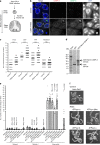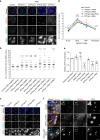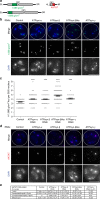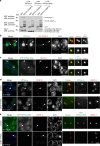ATP synthase F1 subunits recruited to centromeres by CENP-A are required for male meiosis
- PMID: 30006572
- PMCID: PMC6045659
- DOI: 10.1038/s41467-018-05093-9
ATP synthase F1 subunits recruited to centromeres by CENP-A are required for male meiosis
Abstract
The histone H3 variant CENP-A epigenetically defines the centromere and is critical for chromosome segregation. Here we report an interaction between CENP-A and subunits of the mitochondrial ATP synthase complex in the germline of male Drosophila. Furthermore, we report that knockdown of CENP-A, as well as subunits ATPsyn-α, -βlike (a testis-specific paralogue of ATPsyn-β) and -γ disrupts sister centromere cohesion in meiotic prophase I. We find that this disruption is likely independent of reduced ATP levels. We identify that ATPsyn-α and -βlike localise to meiotic centromeres and that this localisation is dependent on the presence of CENP-A. We show that ATPsyn-α directly interacts with the N-terminus of CENP-A in vitro and that truncation of its N terminus perturbs sister centromere cohesion in prophase I. We propose that the CENP-A N-terminus recruits ATPsyn-α and -βlike to centromeres to promote sister centromere cohesion in a nuclear function that is independent of oxidative phosphorylation.
Conflict of interest statement
The authors declare no competing interests.
Figures





Similar articles
-
A dynamic population of prophase CENP-C is required for meiotic chromosome segregation.PLoS Genet. 2023 Nov 29;19(11):e1011066. doi: 10.1371/journal.pgen.1011066. eCollection 2023 Nov. PLoS Genet. 2023. PMID: 38019881 Free PMC article.
-
Imaging and Quantitation of Assembly Dynamics of the Centromeric Histone H3 Variant CENP-A in Drosophila melanogaster Spermatocytes by Immunofluorescence and Fluorescence In-Situ Hybridization (Immuno-FISH).Methods Mol Biol. 2018;1832:327-337. doi: 10.1007/978-1-4939-8663-7_18. Methods Mol Biol. 2018. PMID: 30073536
-
CENP-C functions in centromere assembly, the maintenance of CENP-A asymmetry and epigenetic age in Drosophila germline stem cells.PLoS Genet. 2021 May 20;17(5):e1009247. doi: 10.1371/journal.pgen.1009247. eCollection 2021 May. PLoS Genet. 2021. PMID: 34014920 Free PMC article.
-
Maternal inheritance of centromeres through the germline.Curr Top Dev Biol. 2020;140:35-54. doi: 10.1016/bs.ctdb.2020.03.004. Epub 2020 Apr 25. Curr Top Dev Biol. 2020. PMID: 32591081 Review.
-
Centromeres Drive a Hard Bargain.Trends Genet. 2017 Feb;33(2):101-117. doi: 10.1016/j.tig.2016.12.001. Epub 2017 Jan 7. Trends Genet. 2017. PMID: 28069312 Free PMC article. Review.
Cited by
-
ATP synthase is required for male fertility and germ cell maturation in Drosophila testes.Mol Med Rep. 2019 Mar;19(3):1561-1570. doi: 10.3892/mmr.2019.9834. Epub 2019 Jan 8. Mol Med Rep. 2019. PMID: 30628672 Free PMC article.
-
Protein signatures of seminal plasma from bulls with contrasting frozen-thawed sperm viability.Sci Rep. 2020 Sep 4;10(1):14661. doi: 10.1038/s41598-020-71015-9. Sci Rep. 2020. PMID: 32887897 Free PMC article.
-
RNA interference protocols for gene silencing in the spittlebug Philaenus spumarius, vector of Xylella fastidiosa.Sci Rep. 2024 Oct 28;14(1):25812. doi: 10.1038/s41598-024-73889-5. Sci Rep. 2024. PMID: 39468170 Free PMC article.
-
Gametic specialization of centromeric histone paralogs in Drosophila virilis.Life Sci Alliance. 2021 May 13;4(7):e202000992. doi: 10.26508/lsa.202000992. Print 2021 Jul. Life Sci Alliance. 2021. PMID: 33986021 Free PMC article.
-
Identification of potential core genes and miRNAs in testicular seminoma via bioinformatics analysis.Mol Med Rep. 2019 Nov;20(5):4013-4022. doi: 10.3892/mmr.2019.10684. Epub 2019 Sep 16. Mol Med Rep. 2019. PMID: 31545448 Free PMC article.
References
Publication types
MeSH terms
Substances
Grants and funding
LinkOut - more resources
Full Text Sources
Other Literature Sources
Molecular Biology Databases

